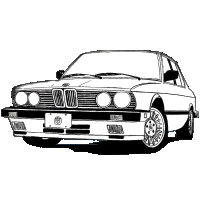Body: Difference between revisions
From The E28 Wiki
No edit summary |
No edit summary |
||
| (5 intermediate revisions by the same user not shown) | |||
| Line 1: | Line 1: | ||
The E28 has a self-supporting body that is welded to the body platform. The passenger cell is a safety passenger cell with deformation elements both in the front and rear of the vehicle. Unlike its E12 predecessor and E34 successor, the E28 has a rear-hinged bonnet. The boot has a volume of | {{PAGEBANNER:|toc=yes}} | ||
The E28 has a self-supporting body that is welded to the body platform. The passenger cell is a safety passenger cell with deformation elements both in the front and rear of the vehicle. Unlike its E12 predecessor and E34 successor, the E28 has a rear-hinged bonnet. The boot has a volume of 460 L (122 US gal). Most models have a fuel tank capacity of 70 L (18 US gal), with some models having a smaller tank of 63 litres (17 US gal). The kerb weight is 1,140–1,410 kg (2,513–3,109 lb). | |||
== Paint == | |||
== Bumpers == | |||
US v Euro | |||
Euro bumper conversions | |||
== Rear Spoiler == | |||
variants | |||
== Touring == | |||
Shultz etc… | |||
[[Category:E28 Information]] | |||
Latest revision as of 20:39, 5 January 2025
The E28 has a self-supporting body that is welded to the body platform. The passenger cell is a safety passenger cell with deformation elements both in the front and rear of the vehicle. Unlike its E12 predecessor and E34 successor, the E28 has a rear-hinged bonnet. The boot has a volume of 460 L (122 US gal). Most models have a fuel tank capacity of 70 L (18 US gal), with some models having a smaller tank of 63 litres (17 US gal). The kerb weight is 1,140–1,410 kg (2,513–3,109 lb).
Paint
Bumpers
US v Euro
Euro bumper conversions
Rear Spoiler
variants
Touring
Shultz etc…
